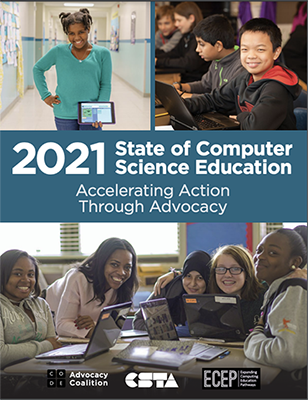2021 State of Computer Science Education

On November 3rd, Code.org, the Computer Science Teachers Association, and the Expanding Computing Education Pathways Alliance, released the 2021 State of Computer Science Education: Accelerating Action Through Advocacy. Published annually, the report provides the most comprehensive analysis of national progress in computer science education, featuring national and state-level policy and implementation data with a focus on equity and diversity.
Last year’s report had data on the participation of students served under the Individuals with Disabilities Education Act (IDEA) in computer science in 11 states. This year’s report has data on the participation of students served under both IDEA and Section 504 of the Rehabilitation Act in computer science in 19 states. Both of these categories are needed to count all K-12 students who have a disability and receive accommodations. In summary, students with 504 plans are slightly overrepresented in foundational high school computer science courses, but students with Individual Education Programs (IEPs) under IDEA are underrepresented. Data listed for each of the 19 states shows the percentage participation of students with disabilities in those states.
One table on page 107 shows the demographics of K-12 students in all 50 states in eleven categories including race/ethnicity categories, English language learners, economically disadvantaged, students with 504 plans, and students under IDEA. This remarkable table can be useful to all states in understanding their population of K-12 students. In total, 2.7% of K-12 students have 504 plans and 14% of students have IEPs.